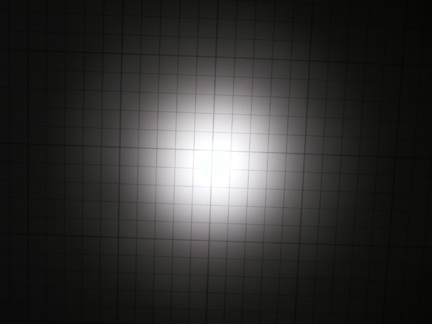

All of the photos in the group below were taken with the same exposure setting: F2.0 1/125"
The lights were approximately 18" away from a paper grid. The grid squares are just over 3/4"
The photos were not cropped so relative sizes of beam are true to scale. In most cases, the direct
or perimeter beam was not bright enough to be picked up with the exposure settings. In many cases, this
beam is significant in the absence of other light sources and very visible to the naked eye. The intent here
was to focus on the reflected beam.
Two exceptions are the first image below and the Royal Blue 5W flood beams. In these cases, the reflected
beam actually extends to the limit of the photo. Gradations are apparent.


Two shots above are with a BB500 in a mini-mag. First shot is with a McLux flood reflector, second shot with
standard optics (1W Low Dome emitter)


Two shots above are both E1e heads with reflectors managing first a 1W HD and second a 1W SE at 500 mA


Two shots above are both Cyan 1W. First is a HD at 500mA and second is a SE at 400mA


Two shots above are both cyan 5W's. First is in an E2e at 400 mA and second is in a KT turbo at 660mA (both are HD)


The two shots above are, first, a red 1W HD in E1e at 500 mA and second a stock E2e incandescent


The two shots above, first a KL1 driven by 3 123 cells (9V) and second, Mr. Bulk's LGI
Both use 1W LD emitters and standard NX05 optics


Above, first is an E1e with NewBeam module and second is an Inova X5 (3 and 5 Nichia 5 mm LED's respectively.

Above, an Arc LS1 (1W LD with NX05 optics)

Above, a Royal Blue 5W HD driven at 500mA in custom flood reflector

Above is a 5W HD white driven at 700 mA in a KT turbo head
Below are photos comparing two 5W white emitters in a side by side shot. Both are in
E2e's using the reflector within. On the left is a SE and on the right, a HD. Both are under driven
at 500 mA.


Bernhard Keissling from Germany commissioned a black McLux with an amber Side Emitter
Luxeon. Surprisingly, even though the McFlood reflector is used, the Amber SE has a very bright
and distinct center beam of considerable intensity. The target is about 6" away in image below:

Below, the the same 1 watt low dome LED is used behind 4 different optics: from Left Top and
clockwise, they are, NX01, NX02, a 30 mm collimator and then a Fraen 6 degree optic designed
for the Low Dome (bat wing) LED's. The LED is driven at 700 mA constand current from a bench
supply.

Lux readings (at one meter):
NX01 - 490
NX05 - 600
Fraen - 750
30 mm - 1240
Below, a 5 Watt High Dome (U4?) was coupled with a NX05 and 30 mm optic as well as placed
in a KT turbo head. The LED was driven at constant current of 700 mA.

Above, NX05 on the left and 30 mm optic on the right; Below, 30 mm on left and
turbo reflector on the right:

The target was about 18" from the LED. The dark center in the turbo beam disappears at
about 3 feet and a small dark center appears in the beam of the 30 mm at about 10 feet.
Lux readings from one meter:
NX05 - 510
30 mm - 1370
Turbo - 960

5W Luxeon with 30 mm optic:
Above, the beam shot on the left was adjusted in PhotoShop with reduced intensity (middle)
and then increased intensity (right). The Optic consists of two elements, a ball and tube. The
ball projects a larger and dimmer image of the die of the LED. This is the square pattern
and you can make out the dark segments of the die "grid". The tube uses TIR to concentrate
the light in a moderately tight round beam. There is a noticeable small null right in the center
of the beam. This null grows proportionally with the beam as the target gets further from the
light. With a single sample of LED and optic, it is uncertain if this artifact is typical.
A beam series of the KL and some PR lights